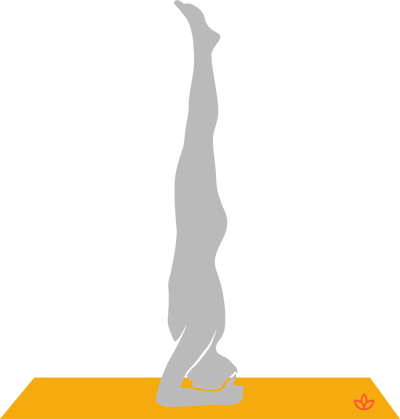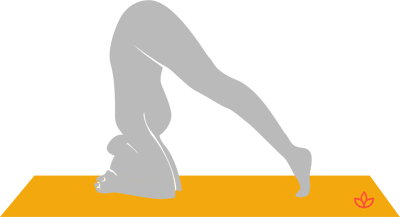Editor's Note: This article was originally published January 3, 2017. It was updated and republished August 19, 2020.
Headstand, called sirasana in Sanskrit, can be a fantastic asana, both for your body and your mind. It lets you enjoy the benefits of inversions, reversing the direction of gravity on your body and the concentration and courage it requires is excellent for focusing your mind.
However, headstand does mean your head and neck become weight-bearing. The potential for injury to the cervical spine is why we need to practice headstand with the utmost attention.
If a headstand practice comes with poor technique, alignment or over-repetition, this risk is heightened. By hyper-extending the neck, or shifting to one side, the yogi also risks nerve damage.
These are not risks to be taken lightly.
So, what is the safest way to practice headstand?
Unless You’re Injury-Free, Skip It!
For those with neck, upper back or shoulder injuries, headstand is not the pose for you right now. The risks of injury from headstand position far outweigh the benefits of the pose if the yogi has existing medical conditions or problem. Existing inflammation, weakness or misalignment can cause more damage to the already weakened areas.
However, that doesn't mean you'll never be able to commit to headstand pose. With proper warming up and consultation from you primary care physician, most yogis will be able to enter this pose over time.
Read: How to Prep For Inversions
Take Instruction From a Qualified and Experienced Teacher
There are plenty of videos online about how to come into headstand, and many of these contain great advice. However, the safest way to learn headstand is under the supervision of an experienced yoga teacher.
They can assess whether you have the strength to support yourself, can advise on building your body awareness, balance and proprioception; most importantly, they can check your alignment.
Read: 10 Benefits of Inversions
Learn Supported Headstand First
By far the safest headstand to perform is supported headstand. In this version, the arms form a support around the head, and the forearms take a significant proportion of the body’s weight. This is so that minimal weight is transferred through the head and neck.

- To come into supported headstand, begin by coming to a kneeling position first.
- Measure the distance between your elbows by clasping opposite biceps, then interlace your fingers so that your forearms are braced on the mat, forming two sides of an equilateral triangle.
- Place the crown of your head down, so that the back of your head is supported by your hands, then walk your feet in toward your hands, coming into half headstand pose (ardha sirasana) with your head on the ground.

- Before you even try to lift your legs, practice pressing your forearms into the mat, doming between your shoulder blades, to take the weight off your head.
- Build strength in this position before going any further.
Come up Slowly and With Control
The most vulnerable stage for your neck in a headstand is the entry phase. At this point, you are most likely to take a higher proportion of your body weight through your neck. The dynamic nature of moving into the pose means it is also the least stable phase.
One study, which carefully analyzed the impact of headstand on the head and neck in a number of experienced yoga practitioners, found that those who “kick up” into headstand by lifting one leg are at greatest risk of injury [1]. This is because entry into the pose in this way is the least predictable and most difficult to perform with consistency and control. It brings the fastest loading rates, which can mean your muscles tense, increasing the risk of support failure and injury.
The study found that the safest way to enter the pose is by entering with straight legs that lift simultaneously. If this is done very slowly, it results in the least amount of cervical flexion and the most gradual weight loading.
This variation does require more core strength, and may be problematic for those with lower back issues. So, an alternative is to lift both knees into the chest, coming into a tuck position, then straightening the legs.
Read: A 15-Minute Yoga Sequence for Core Strength
Avoid Kicking up to a Wall
Many practitioners learn headstand against the wall, and having a wall for safety can be helpful to avoid toppling out of the asana. However, if you are using a wall, resist the temptation to kick up to it and catch yourself with it.
As discussed, kicking up is the least safe way to come into a headstand, and should be avoided. Go for both legs together or knees into the chest first.
Here are a few more reasons why you should avoid using a wall to master your headstand.
Walls Hinder Your Balance
Being too close to the wall prevents you from finding your balance point. When you enter headstand, your hips initially need to move further over your head and arms in order to counterbalance your legs, then they move back toward your mid-line once you’ve found your balance.
If you’re too close to the wall, you won’t learn to feel this counterbalance.
Kicking Up Leads to Backbend
Kicking up to the wall will take you into a backbend. Generally, if your feet end up touching the wall, you’re risking a few things. First, chances are, you’re collapsing into your lower back, and it’s much harder for your core to then find your way back to upright. Secondly, you’re at greater risk of bringing your neck out of neutral alignment, either by over-flexing it, or more likely, hyper-extending it.
If you do have a wall there, make sure it’s only to stop you from completely tumbling over and that you are far enough away from it that you have the space to come up without touching it.
Read: Think Headstand Is Scary? 3 Tricks to Help Conquer Your Fear
Keep Your Weight in Your Forearms
Once you’re in headstand, most yogis tend to redistribute their weight so that more of it is coming through their head and neck and less through their arms. The longer you hold the pose, the more this happens.
To counteract this, actively maintain your focus on pressing the forearms into the ground and keeping the weight off your head. Avoid holding headstand past the point where your arms begin to tire. Build your strength gradually so that your arms are always able to support you.
Exit Safely
Just like entering a headstand, the safest way out is slowly, symmetrically and with control. Lower the legs together and straight to the ground, or draw the knees into the chest first then take the feet down. Either way, maintain the pressure into the arms on the way down, and be mindful of the position of your neck. Keep it neutral.
Even when following all these points, headstand is not a risk-free asana. Yes, it can have real benefits, but think seriously about whether it’s worth it for you.
If you decide against it, there are a whole host of arm balances and forearm stands that have similar benefits of inverting your body without placing extra strain on your neck. Stay safe, and happy practicing.
[1] Hector, R. & Jensen, J.L. (2015). Sirasana (headstand) technique alters head/neck loading: Considerations for Safety. Journal of Bodywork & Movement Therapies, 19, 434-441
During These Times of Stress and Uncertainty Your Doshas May Be Unbalanced.
To help you bring attention to your doshas and to identify what your predominant dosha is, we created the following quiz.
Try not to stress over every question, but simply answer based off your intuition. After all, you know yourself better than anyone else.